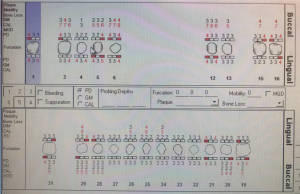Case Presentation – Managing Patients with Medical Conditions
In this case study, I will demonstrate how I managed a patient with a chronic medical condition. Mr. D, a 55-year-old Latino male, presented to the dental hygiene clinic with a chief complaint statement that he hadn’t been to the dentist in a while and came to the clinic for a dental cleaning. Mr. D expressed he felt the appearance of his teeth were just “okay” and thought they could use some improvement. He admitted feeling self-conscious about wearing a partial denture. As Mr. D was removing his partial denture so it can be cleaned, I observed he kept his mouth covered with a tissue.
Medical Hx Interview:
Mr. D. was diagnosed with hypertension approximately a year ago and is considered an ASA II patient. He takes Losartan Potassium 100mg/day for the treatment of high blood pressure. Initial blood pressure (BP) reading was 143/73, pulse reading was 75. At Mr. D’s second visit, his BP reading was 140/69, and his pulse reading was 74.
Clinical Oral Exam Findings:
Extra oral findings, unilateral clicking of the TMJ on the left side (asymptomatic), red macule on the occipital center of the neck (patient confirmed it is a birth mark). Intra oral findings, scalloped and coated tongue, a leukoplakia lesion less than 1cm in size, flat with regular borders on the left buccal mucosa near the second molar. Class of occlusion: type I, overjet and overbite were not recorded due to patient missing maxillary anterior teeth. Dental charting: class I and II composite restorations on teeth #1, #3, #5, #12, #13, #15, #16, #20, & #31. Porcelain Fused to Metal (PFM) crown and Root Canal Therapy (RCT) on teeth #4, & #19. Fractured teeth #6 & #16. Overhang restoration on tooth #5/-Distal surface. Partial removable denture for teeth #7-11. Localized attrition on teeth #21-27 and abfraction on teeth #6, #12, and #29. Calculus deposits: generalized subgingival calculus on the interproximal surfaces of posterior teeth with localized supragingival calculus on the mandibular anterior teeth. Patient presented with no stains. Gingival description: localized pink color gingival with localized redness on maxillary premolars and mandibular anterior teeth, localized spongy consistency on maxillary premolars and mandibular anterior teeth, generalized blunted interproximal space with generalized non–stippled present.
Periodontal Status:
Patient was assessed as a periodontal case type II due to generalized moderate recession with localized severe recession on lower mandibular teeth and generalized horizontal bone loss. Probing depths: generalized 2-3mm probing depths with localized 4-5mm on the maxillary and mandibular posterior teeth. Bleeding upon probing: generalized moderate bleeding and localized moderate inflammation on maxillary premolar and mandibular anterior teeth.
Click here for a complete report and treatment
Perio Chart:
Radiographs:
Arestin
A 54 year old Latina female presented to the dental clinic for a routinely dental cleaning. The patient was assessed as a medium- Periodontal case type II with localized 5-6mm probing depths on molars and generalized 2-3 probing depths on premolars and anterior teeth. After taking horizontal bitewings, the patient was diagnosed with generalized vertical bone loss on posterior teeth. Assessment of the patient’s gingiva revealed a generalized pink color with localized redness of the interdental papilla on maxillary molars, generalized firm and resilient consistency with localized spongy consistency on molars, and minimal bleeding upon probing. The patient stated using a soft bristle manual toothbrush twice daily with up and down motions, Sensodyne toothpaste, and occasional flossing with waxed floss.
The treatment plan for this patient was to complete the dental cleaning within two consecutive visits and have the patient implement recommended daily oral hygiene, such as flossing and brushing with the Modified Bass Method technique, which I assessed was the adequate method for this patient. After completing the dental cleaning, the patient came back after two weeks for a re-evaluation visit to determine if the areas of deep periodontal pocketing had improved, or if Arestin therapy would be necessary to manage the areas further. Upon re-evaluation, I assessed some areas needed further management, so I placed Arestin on teeth #2B, #2BM, #3BM, #3BM, #14BM, #15BM, #2LM, and #3LD.
The patient came back four weeks after the initial placement of Arestin for re-evaluation. The probing depths reduced in some areas by 1mm; however, some sites remained the same and two other sites probing depths increased from 6mm to 7mm. The patient mentioned she had not ben consistent with the flossing, but expressed she understood the importance of implementing flossing after realizing that the medication did not work in certain areas of the mouth, and those areas of disease could progress on a bigger problem in the future.
Click here to find out more about my experience placing Arestin
Radiographs:





